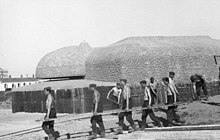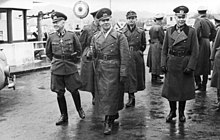World War II in the Basque Country
World War II in the Basque Country (a region in northern Spain and southwestern France) refers to the period extending from 1940 to 1945. It affected the French Basque Country (a region in southwest France), but also bordering areas across the Pyrenees on account of the instability following the end of the Spanish Civil War, and the friendly ties between Germany, Vichy France, and the triumphant Spanish military dictatorship.
Fallout of the Spanish Civil War

In June 1937, the
in Mars-April 1939. It lasted up to 1945.The population's reception to the Spanish refugees, perceived as 'reds', was generally negative, since the
Outbreak of World War II



In 1940
The occupied zone ran on the German time zone.
During wartime, many in France supported the Nazi regime and its persecution of Jews, communists, and foreigners. Others resisted, but were deeply divided.
In the western Pyrenees, especially the
End of the occupation in French zone
Petain's Vichy France fell starting November 1942, with the Germans taking over all its former territory. The Maquis in Soule helped liberate Mauleon (Maule in Basque) and Tardets (Atharratze).[8] The Nazi occupation of the Basque Country came to an end in 1944, after German troops definitely retreated following the Allied counteroffensive.[9] However, the Germans found time enough to stretch out their Atlantic Wall up to Hendaye, leaving its remains behind, still on-sight today.
The active Basques evacuated on the final stage of the northern front in the Spanish Civil War joined the Allied forces and played a critical role in the Pointe de Grave battle with their Gernika Battalion (Gironde). De Gaulle commented, "France will never forget the sacrifice of the Basques for the liberation of our land."[9] The long-standing conservative weekly Eskualduna was shut down in 1944,[10] for its support to the Vichy regime and the collaborationist stance shown with the Germans. It was replaced by Herria, conducted by Piarres Lafitte.[10]

On 7 May 1945, the day of
Footnotes
- ISBN 1-877802-16-6.
- ^ "Euskaldunak Bigarren Mundu Gerran". Auñamendi Eusko Entziklopedia. EuskoMedia Fundazioa. Retrieved 25 October 2015.
- ISBN 1-877802-16-6.
- ^ Jackson, J. (2003), pp. 246-247
- ^ Jackson, J. (2003), p. 247
- ISBN 1-877802-16-6.
- ^ Watson, Cameron (2003), p. 233
- ^ a b c Watson, Cameron (2003), p. 234
- ^ a b Watson, Cameron (2003), p. 235
- ^ OCLC 1264219932.
- ^ del Hierro 2021, pp. 764–65.
- ^ Largo, Gontzal (10 May 2009). "Érase un fragmento de un Heinkel 111". El Diario Vasco (in Spanish). Archived from the original on 25 August 2014. Retrieved 23 September 2021.
- ^ del Hierro 2021, p. 762.
Sources
- del Hierro, Pablo (2021). "The End of the Affair: The International Dispute over the Deportation of Degrelle from Spain to Belgium, 1945–1946". .
- Jackson, J. (2003). France: The Dark Years, 1940–1944. Oxford University Press. pp. 246–247. ISBN 0-19-925457-5.
- Jimenez, J. C. (2019). "Euskaldunak Bigarren Mundu Gerran". Auñamendi Entziklopedia (in Basque). Retrieved 28 March 2015.
- Watson, C. (2003). Modern Basque History: Eighteenth Century to the Present. Center for Basque Studies. University of Nevada. ISBN 1-877802-16-6.
